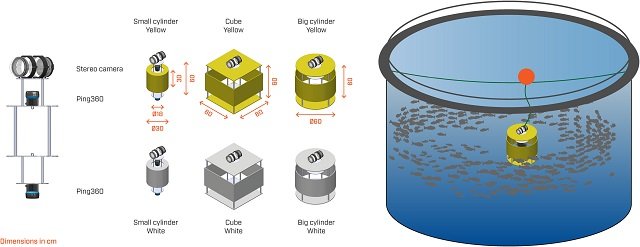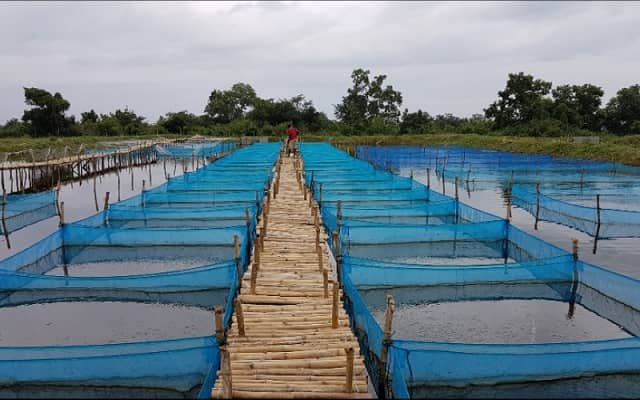
With the rise of precision aquaculture practices and the expansion of fish farms to more exposed locations, submersible vehicles and mobile platforms are becoming increasingly common tools in the aquaculture industry.
While their applications, such as cleaning and inspecting nets, are well-established, the potential impact of these technologies on fish welfare remains largely unexplored.
In this regard, scientists from NTNU and SINTEF Ocean explored how the physical properties of an intrusive object affect the responses of farmed Atlantic salmon. They measured the avoidance distance exhibited by salmon exposed to structures of various shapes, sizes, and colors.
Methodology
Field tests for the study were conducted at an industrial-scale fish farm at SINTEF ACE. The fish were stimulated in an experimental setup where external impact factors (shapes, sizes, and colors) were varied to assess their effects.
Six different object designs were implemented inside commercial net cages, representing variations in size, shape (spherical versus cylindrical), and color (yellow versus white). 360-degree onboard sonars monitored the fish distribution around these objects.
Cumulative fish presence images were created by adding sonar data at intervals of 1, 5, and 10 minutes to enhance data robustness. A deep learning approach using the UNet++ architecture was employed to automatically segment fish distribution patterns, facilitating the assessment of the average distance between the inner perimeter of fish distribution and the object.
Key Results
“This study successfully measured differences in fish responses around structures of variable shape, size, and color using a novel machine learning distance-avoidance study approach. It employed a deep learning semantic segmentation approach to automatically determine fish swimming patterns around a structure,” highlight the researchers.
Here are the main findings:
Stay Always Informed
Join our communities to instantly receive the most important news, reports, and analysis from the aquaculture industry.
- Fish exhibit avoidance behavior toward larger objects: The study revealed a clear correlation between object size and the distance maintained by the fish. Larger objects triggered a greater avoidance response, suggesting a potential threshold beyond which fish experience increased discomfort or stress.
- Shape appears less influential: While the impact of size was significant, variations in shape (spherical versus cylindrical) did not show a clear influence on fish behavior. This implies that size, rather than a specific geometric shape, plays a more crucial role in shaping fish responses.
- Color affects distance preference: Interestingly, fish maintained greater distances from yellow objects compared to white ones, suggesting a possible association between color and perceived threat or risk. Further research is needed to understand the underlying mechanisms behind this color-related behavior.
- Larger fish show higher avoidance: A positive linear relationship was observed between fish size (age) and the distance maintained from objects. This translates to an average avoidance distance of 3.8 body lengths, underscoring the importance of considering fish size when designing and implementing underwater tools in fish farms.
Implications and Future Directions
These findings provide valuable insights into the potential impact of submersible vehicles and mobile platforms on fish welfare in open-sea aquaculture. The scientists recommend that “sensors, robots/UUVs, and other technological tools dedicated to aquaculture applications should strive to minimize disturbances induced on fish while remaining effective for the intended purpose.”
By understanding the dynamics between fish behavior and object characteristics, researchers and fish farm operators can design tools and implement operational practices that minimize disturbances and promote optimal health and welfare for fish.
Conclusions
“In this paper, we have developed a sonar data processing method based on DL to identify and quantify fish responses under different impact factors during fish farm operations. The method has been successfully applied to relevant sonar data collected in field trials to study the distance fish avoid in reaction to structures with different shapes, sizes, and colors,” conclude the researchers.
Further studies are needed to explore the long-term effects of exposure to objects on stress levels, growth, and overall fish welfare. Additionally, research on the behavioral responses of other commercially important fish species to different types of objects and operational scenarios would further refine our understanding and guide the development of sustainable and fish-friendly aquaculture technologies.
By prioritizing animal welfare and incorporating this knowledge into technological development and operational practices, the aquaculture industry can ensure the responsible and sustainable use of submersible vehicles and mobile platforms, fostering a thriving industry that prioritizes environmental and economic goals.
The study has been funded by the Research Council of Norway (RCN) under the CHANGE project.
Contact
Eleni Kelasidi
Department of Aquaculture Technology
SINTEF Ocean
7010 Trondheim, Norway
Email: eleni.kelasidi@sintef.no
Reference (open access)
Qin Zhang, Nina Bloecher, Linn Danielsen Evjemo, Martin Føre, Biao Su, Espen Eilertsen, Mats Aarsland Mulelid, Eleni Kelasidi. 2023. Farmed Atlantic salmon (Salmo salar L.) avoid intrusive objects in cages: The influence of object shape, size and colour, and fish length, Aquaculture, 2023, 740429, ISSN 0044-8486, https://doi.org/10.1016/j.aquaculture.2023.740429.
Editor at the digital magazine AquaHoy. He holds a degree in Aquaculture Biology from the National University of Santa (UNS) and a Master’s degree in Science and Innovation Management from the Polytechnic University of Valencia, with postgraduate diplomas in Business Innovation and Innovation Management. He possesses extensive experience in the aquaculture and fisheries sector, having led the Fisheries Innovation Unit of the National Program for Innovation in Fisheries and Aquaculture (PNIPA). He has served as a senior consultant in technology watch, an innovation project formulator and advisor, and a lecturer at UNS. He is a member of the Peruvian College of Biologists and was recognized by the World Aquaculture Society (WAS) in 2016 for his contribution to aquaculture.




